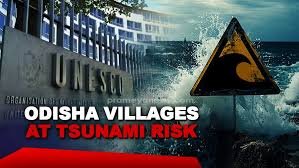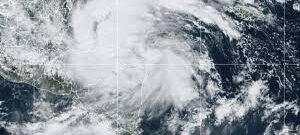Odisha’s 24 Coastal Villages Recognized as Tsunami Ready by UNESCO
Introduction to the Recognition of Odisha’s Coastal Villages In a significant achievement, 24 coastal villages in Odisha have been officially recognized as “Tsunami Ready” by the United Nations Educational, Scientific and Cultural Organization (UNESCO). This prestigious recognition underscores the remarkable preparedness of these villages to handle and respond to tsunami-related disasters, ensuring the safety and security of their residents in the event of such natural calamities.
Key Features of Tsunami-Ready Villages The recognition of these villages is based on their implementation of comprehensive tsunami preparedness measures. These measures include effective early warning systems, community-based evacuation plans, and the establishment of evacuation routes and shelters. Odisha has become the first state in India to achieve such an accomplishment, which reflects the government’s commitment to disaster risk reduction and community resilience in coastal regions.
The Role of UNESCO in Tsunami Preparedness UNESCO’s recognition is part of its broader initiative to promote the “Tsunami Ready” program across vulnerable coastal communities worldwide. The program aims to reduce the loss of life and property during tsunami events by enhancing preparedness at the grassroots level. These villages in Odisha have undergone rigorous evaluation based on parameters like local tsunami response protocols, infrastructure, and awareness campaigns.
Impact on Local Communities For the residents of these 24 villages, the recognition is a testament to the community’s dedication to building resilience. The ongoing efforts to enhance public awareness about tsunami risks and safety measures have resulted in better preparedness and a stronger collective response. Local authorities, in collaboration with communities, have ensured that people are well-equipped to respond effectively to tsunami warnings.

Why This News Is Important
Tsunami Preparedness Is a Critical Factor in Coastal Safety The recognition of Odisha’s coastal villages by UNESCO highlights the importance of tsunami preparedness in saving lives and minimizing the impact of natural disasters. For India, a nation with a long coastline and vulnerability to tsunamis, this recognition serves as an example for other coastal regions to enhance their disaster management strategies.
Positive Impact on Government Policies The success in Odisha reflects the positive outcome of government policies focused on disaster risk reduction. It encourages other states to follow suit by adopting similar initiatives to protect coastal populations from tsunamis and other natural hazards. Additionally, it aligns with India’s broader national policies and commitments to disaster resilience under frameworks like the Sendai Framework for Disaster Risk Reduction.
Global Recognition for Local Efforts This achievement puts Odisha on the global map for its proactive stance on tsunami preparedness. It demonstrates that local communities, when empowered with the right tools and knowledge, can make a significant difference in disaster management. It sets a global precedent for other nations facing similar coastal risks to invest in disaster preparedness initiatives.
Inspiration for Community-Driven Initiatives The program highlights the critical role of community involvement in disaster management. These villages have shown that, with proper training and resources, even the most vulnerable communities can be equipped to face tsunami threats. This could lead to an increase in grassroots-level disaster preparedness initiatives in other vulnerable regions.
Strengthening India’s Disaster Resilience With India being prone to several natural disasters, including tsunamis, floods, and cyclones, strengthening the country’s disaster resilience is a national priority. This achievement in Odisha is a step toward ensuring the safety and well-being of millions of people living in coastal areas.
Historical Context: Background Information on Tsunami Preparedness and Odisha’s Coastal Vulnerability
India’s Vulnerability to Tsunamis India, with its extensive coastline stretching over 7,500 kilometers, has been historically vulnerable to natural disasters, including tsunamis. The 2004 Indian Ocean tsunami, one of the most devastating in history, caused widespread damage along India’s eastern coastline, particularly in Tamil Nadu and the Andaman and Nicobar Islands. This tragedy emphasized the need for robust disaster preparedness systems in coastal regions.
Development of Tsunami Preparedness Programs In response to the 2004 disaster, India began taking significant steps toward improving its tsunami warning systems and disaster management infrastructure. The Indian National Centre for Ocean Information Services (INCOIS) was established to issue early tsunami warnings, and various states, especially those along the eastern coast, developed tsunami preparedness programs.
Odisha’s Focus on Coastal Disaster Risk Reduction Odisha, one of the most tsunami-prone states in India, has been proactive in strengthening its coastal disaster preparedness. The state’s efforts to reduce risks from tsunamis and cyclones are part of its broader strategy to safeguard its population. The collaboration between the state government, local authorities, and international organizations like UNESCO has been pivotal in achieving this milestone.
UNESCO’s Tsunami Ready Program UNESCO launched the “Tsunami Ready” program to help coastal communities worldwide develop effective disaster management strategies. The program provides a comprehensive framework for communities to develop tsunami warning systems, evacuation plans, and other essential safety measures. Odisha’s recognition by UNESCO is a culmination of years of hard work in line with these global standards.
Key Takeaways from Odisha’s Tsunami-Ready Recognition
| Serial No. | Key Takeaway |
|---|---|
| 1 | Odisha’s 24 coastal villages are recognized by UNESCO as “Tsunami Ready.” |
| 2 | The villages have implemented tsunami preparedness measures like early warning systems and evacuation plans. |
| 3 | Odisha is the first state in India to achieve this recognition. |
| 4 | The initiative reflects the state’s commitment to disaster risk reduction and community resilience. |
| 5 | The UNESCO recognition serves as a global example of community-driven disaster preparedness efforts. |
Important FAQs for Students from this News
1. What is the significance of Odisha’s 24 coastal villages being recognized as “Tsunami Ready” by UNESCO?
- This recognition signifies that these villages have met UNESCO’s stringent criteria for tsunami preparedness. The recognition highlights the state’s commitment to disaster risk reduction and ensures better protection for residents in the event of a tsunami.
2. How did these villages become “Tsunami Ready”?
- These villages have implemented effective early warning systems, evacuation plans, awareness campaigns, and evacuation routes and shelters to ensure community safety during tsunami threats.
3. What role does UNESCO play in tsunami preparedness?
- UNESCO’s Tsunami Ready program provides guidelines and resources for coastal communities to prepare for tsunamis. It evaluates and certifies communities that demonstrate robust disaster preparedness measures, aiming to reduce loss of life and property.
4. How does the recognition of Odisha’s villages impact India’s disaster management strategy?
- This achievement sets a positive precedent for other coastal regions in India to improve disaster preparedness. It highlights the importance of community-driven efforts in disaster risk reduction and encourages other states to adopt similar initiatives.
5. Why is tsunami preparedness particularly important for coastal regions like Odisha?
- Coastal regions are vulnerable to tsunamis, which can cause widespread devastation. Odisha, with its long coastline and history of natural disasters, has prioritized tsunami preparedness to safeguard its communities and reduce the impact of such events.
Some Important Current Affairs Links
















